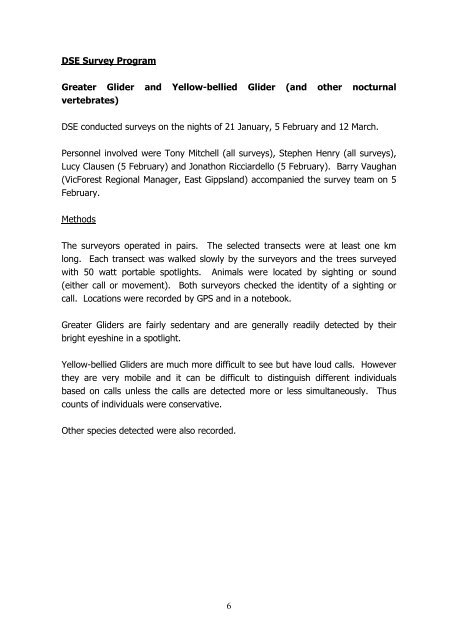Surveys for arboreal mammals, Long-Footed Potoroo and Spiny ...
Surveys for arboreal mammals, Long-Footed Potoroo and Spiny ...
Surveys for arboreal mammals, Long-Footed Potoroo and Spiny ...
Create successful ePaper yourself
Turn your PDF publications into a flip-book with our unique Google optimized e-Paper software.
DSE Survey Program<br />
Greater Glider <strong>and</strong> Yellow-bellied Glider (<strong>and</strong> other nocturnal<br />
vertebrates)<br />
DSE conducted surveys on the nights of 21 January, 5 February <strong>and</strong> 12 March.<br />
Personnel involved were Tony Mitchell (all surveys), Stephen Henry (all surveys),<br />
Lucy Clausen (5 February) <strong>and</strong> Jonathon Ricciardello (5 February). Barry Vaughan<br />
(VicForest Regional Manager, East Gippsl<strong>and</strong>) accompanied the survey team on 5<br />
February.<br />
Methods<br />
The surveyors operated in pairs. The selected transects were at least one km<br />
long. Each transect was walked slowly by the surveyors <strong>and</strong> the trees surveyed<br />
with 50 watt portable spotlights. Animals were located by sighting or sound<br />
(either call or movement). Both surveyors checked the identity of a sighting or<br />
call. Locations were recorded by GPS <strong>and</strong> in a notebook.<br />
Greater Gliders are fairly sedentary <strong>and</strong> are generally readily detected by their<br />
bright eyeshine in a spotlight.<br />
Yellow-bellied Gliders are much more difficult to see but have loud calls. However<br />
they are very mobile <strong>and</strong> it can be difficult to distinguish different individuals<br />
based on calls unless the calls are detected more or less simultaneously. Thus<br />
counts of individuals were conservative.<br />
Other species detected were also recorded.<br />
6





![Metcalfe State Forest Fauna Species List [PDF File - 16.9 KB]](https://img.yumpu.com/22024301/1/184x260/metcalfe-state-forest-fauna-species-list-pdf-file-169-kb.jpg?quality=85)






![PPE Price List for Wildlife Volunteers [PDF File - 20.3 KB]](https://img.yumpu.com/15321634/1/190x135/ppe-price-list-for-wildlife-volunteers-pdf-file-203-kb.jpg?quality=85)




